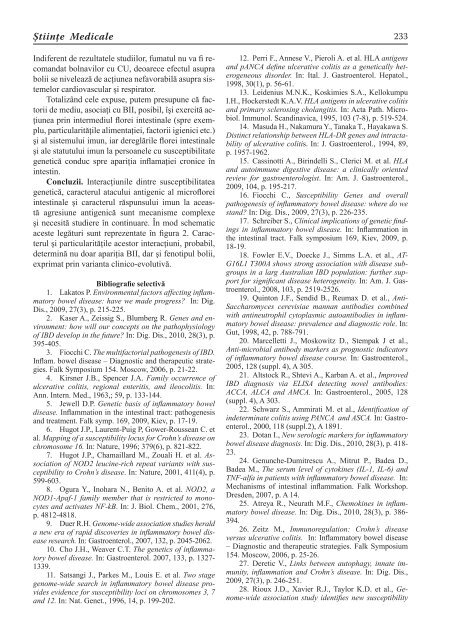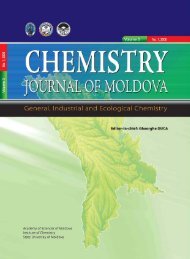stiinte med 3 2011.indd - Academia de ÅtiinÅ£e a Moldovei
stiinte med 3 2011.indd - Academia de ÅtiinÅ£e a Moldovei
stiinte med 3 2011.indd - Academia de ÅtiinÅ£e a Moldovei
Create successful ePaper yourself
Turn your PDF publications into a flip-book with our unique Google optimized e-Paper software.
Ştiinţe Medicale<br />
Indiferent <strong>de</strong> rezultatele studiilor, fumatul nu va fi recomandat<br />
bolnavilor cu CU, <strong>de</strong>oarece efectul asupra<br />
bolii se nivelează <strong>de</strong> acţiunea nefavorabilă asupra sistemelor<br />
cardiovascular şi respirator.<br />
Totalizând cele expuse, putem presupune că factorii<br />
<strong>de</strong> <strong>med</strong>iu, asociaţi cu BII, posibil, îşi exercită acţiunea<br />
prin inter<strong>med</strong>iul florei intestinale (spre exemplu,<br />
particularităţile alimentaţiei, factorii igienici etc.)<br />
şi al sistemului imun, iar <strong>de</strong>reglările florei intestinale<br />
şi ale statutului imun la persoanele cu susceptibilitate<br />
genetică conduc spre apariţia inflamaţiei cronice în<br />
intestin.<br />
Concluzii. Interacţiunile dintre susceptibilitatea<br />
genetică, caracterul atacului antigenic al microflorei<br />
intestinale şi caracterul răspunsului imun la această<br />
agresiune antigenică sunt mecanisme complexe<br />
şi necesită studiere în continuare. În mod schematic<br />
aceste legături sunt reprezentate în figura 2. Caracterul<br />
şi particularităţile acestor interacţiuni, probabil,<br />
<strong>de</strong>termină nu doar apariţia BII, dar şi fenotipul bolii,<br />
exprimat prin varianta clinico-evolutivă.<br />
Bibliografie selectivă<br />
1. Lakatos P. Environmental factors affecting infl ammatory<br />
bowel disease: have we ma<strong>de</strong> progress? In: Dig.<br />
Dis., 2009, 27(3), p. 215-225.<br />
2. Kaser A., Zeissig S., Blumberg R. Genes and environment:<br />
how will our concepts on the pathophysiology<br />
of IBD <strong>de</strong>velop in the future? In: Dig. Dis., 2010, 28(3), p.<br />
395-405.<br />
3. Fiocchi C. The multifactorial pathogenesis of IBD.<br />
Inflam. bowel disease – Diagnostic and therapeutic strategies.<br />
Falk Symposium 154. Moscow, 2006, p. 21-22.<br />
4. Kirsner J.B., Spencer J.A. Family occurrence of<br />
ulcerative colitis, regional enteritis, and ileocolitis. In:<br />
Ann. Intern. Med., 1963,; 59, p. 133-144.<br />
5. Jewell D.P. Genetic basis of infl ammatory bowel<br />
disease. Inflammation in the intestinal tract: pathogenesis<br />
and treatment. Falk symp. 169, 2009, Kiev, p. 17-19.<br />
6. Hugot J.P., Laurent-Puig P, Gower-Roussean C. et<br />
al. Mapping of a susceptibility locus for Crohn’s disease on<br />
chromosome 16. In: Nature, 1996; 379(6), p. 821-822.<br />
7. Hugot J.P., Chamaillard M., Zouali H. et al. Association<br />
of NOD2 leucine-rich repeat variants with susceptibility<br />
to Crohn’s disease. In: Nature, 2001, 411(4), p.<br />
599-603.<br />
8. Ogura Y., Inohara N., Benito A. et al. NOD2, a<br />
NOD1-Apaf-1 family member that is restricted to monocytes<br />
and activates NF-kB. In: J. Biol. Chem., 2001, 276,<br />
p. 4812-4818.<br />
9. Duer R.H. Genome-wi<strong>de</strong> association studies herald<br />
a new era of rapid discoveries in inflammatory bowel disease<br />
research. In: Gastroenterol., 2007, 132, p. 2045-2062.<br />
10. Cho J.H., Weaver C.T. The genetics of infl ammatory<br />
bowel disease. In: Gastroenterol. 2007, 133, p. 1327-<br />
1339.<br />
11. Satsangi J., Parkes M., Louis E. et al. Two stage<br />
genome-wi<strong>de</strong> search in infl ammatory bowel disease provi<strong>de</strong>s<br />
evi<strong>de</strong>nce for susceptibility loci on chromosomes 3, 7<br />
and 12. In: Nat. Genet., 1996, 14, p. 199-202.<br />
233<br />
12. Perri F., Annese V., Pieroli A. et al. HLA antigens<br />
and pANCA <strong>de</strong>fi ne ulcerative colitis as a genetically heterogeneous<br />
disor<strong>de</strong>r. In: Ital. J. Gastroenterol. Hepatol.,<br />
1998, 30(1), p. 56-61.<br />
13. Lei<strong>de</strong>nius M.N.K., Koskimies S.A., Kellokumpu<br />
I.H., Hockerstedt K.A.V. HLA antigens in ulcerative colitis<br />
and primary sclerosing cholangitis. In: Acta Path. Microbiol.<br />
Immunol. Scandinavica, 1995, 103 (7-8), p. 519-524.<br />
14. Masuda H., Nakamura Y., Tanaka T., Hayakawa S.<br />
Distinct relationship between HLA-DR genes and intractability<br />
of ulcerative colitis. In: J. Gastroenterol., 1994, 89,<br />
p. 1957-1962.<br />
15. Cassinotti A., Birin<strong>de</strong>lli S., Clerici M. et al. HLA<br />
and autoimmune digestive disease: a clinically oriented<br />
review for gastroenterologist. In: Am. J. Gastroenterol.,<br />
2009, 104, p. 195-217.<br />
16. Fiocchi C., Susceptibility Genes and overall<br />
pathogenesis of infl ammatory bowel disease: where do we<br />
stand? In: Dig. Dis., 2009, 27(3), p. 226-235.<br />
17. Schreiber S., Clinical implications of genetic fi ndings<br />
in infl ammatory bowel disease. In: Inflammation in<br />
the intestinal tract. Falk symposium 169, Kiev, 2009, p.<br />
18-19.<br />
18. Fowler E.V., Doecke J., Simms L.A. et al., AT-<br />
G16L1 T300A shows strong association with disease subgroups<br />
in a larg Australian IBD population: further support<br />
for signifi cant disease heterogeneity. In: Am. J. Gastroenterol.,<br />
2008, 103, p. 2519-2526.<br />
19. Quinton J.F., Sendid B., Reumax D. et al., Anti-<br />
Saccharomyces cerevisiae mannan antibodies combined<br />
with antineutrophil cytoplasmic autoantibodies in infl ammatory<br />
bowel disease: prevalence and diagnostic role. In:<br />
Gut, 1998, 42, p. 788-791.<br />
20. Marcelletti J., Moskowitz D., Stempak J et al.,<br />
Anti-microbial antibody markers as prognostic indicators<br />
of infl ammatory bowel disease course. In: Gastroenterol.,<br />
2005, 128 (suppl. 4), A 305.<br />
21. Altstock R., Shtevi A., Karban A. et al., Improved<br />
IBD diagnosis via ELISA <strong>de</strong>tecting novel antibodies:<br />
ACCA, ALCA and AMCA. In: Gastroenterol., 2005, 128<br />
(suppl. 4), A 303.<br />
22. Schwarz S., Ammirati M. et al., I<strong>de</strong>ntifi cation of<br />
in<strong>de</strong>terminate colitis using PANCA and ASCA. In: Gastroenterol.,<br />
2000, 118 (suppl.2), A 1891.<br />
23. Dotan I., New serologic markers for infl ammatory<br />
bowel disease diagnosis. In: Dig. Dis., 2010, 28(3), p. 418-<br />
23.<br />
24. Genunche-Dumitrescu A., Mitrut P., Ba<strong>de</strong>a D.,<br />
Ba<strong>de</strong>a M., The serum level of cytokines (IL-1, IL-6) and<br />
TNF-alfa in patients with infl ammatory bowel disease. In:<br />
Mechanisms of intestinal inflammation. Falk Workshop.<br />
Dres<strong>de</strong>n, 2007, p. A 14.<br />
25. Atreya R., Neurath M.F., Chemokines in infl ammatory<br />
bowel disease. In: Dig. Dis., 2010, 28(3), p. 386-<br />
394.<br />
26. Zeitz M., Immunoregulation: Crohn’s disease<br />
versus ulcerative colitis. In: Inflammatory bowel disease<br />
– Diagnostic and therapeutic strategies. Falk Symposium<br />
154. Moscow, 2006, p. 25-26.<br />
27. Deretic V., Links between autophagy, innate immunity,<br />
infl ammation and Crohn’s disease. In: Dig. Dis.,<br />
2009, 27(3), p. 246-251.<br />
28. Rioux J.D., Xavier R.J., Taylor K.D. et al., Genome-wi<strong>de</strong><br />
association study i<strong>de</strong>ntifi es new susceptibility

















